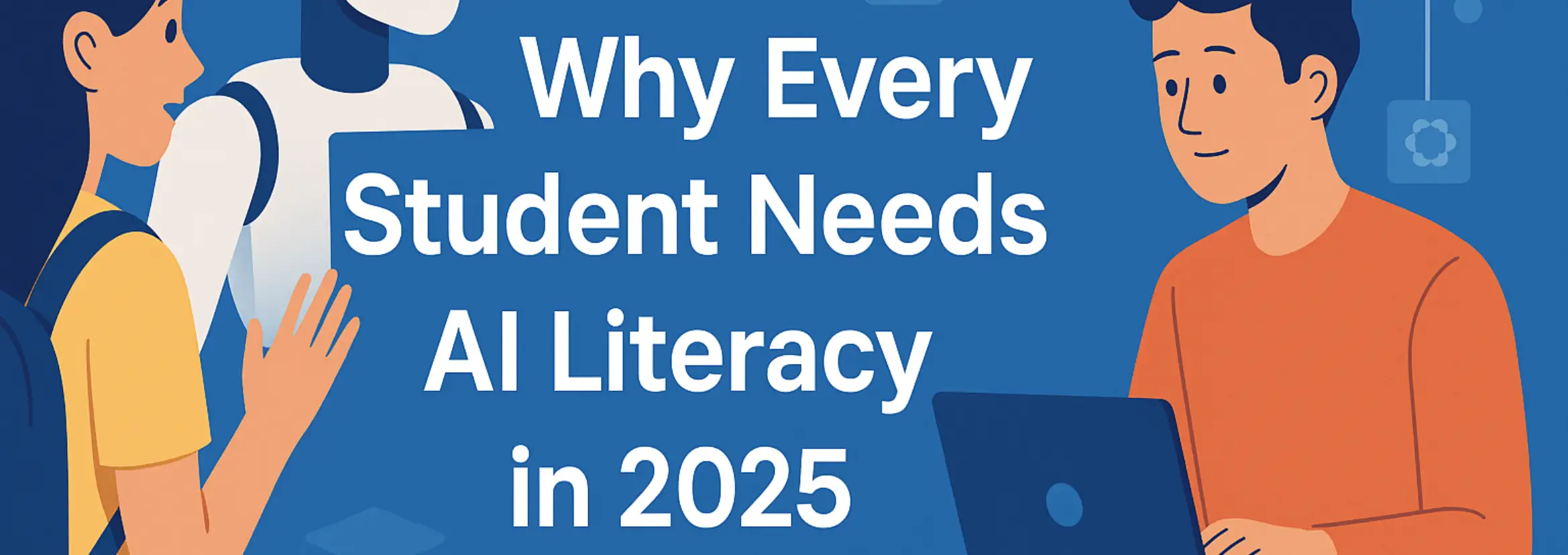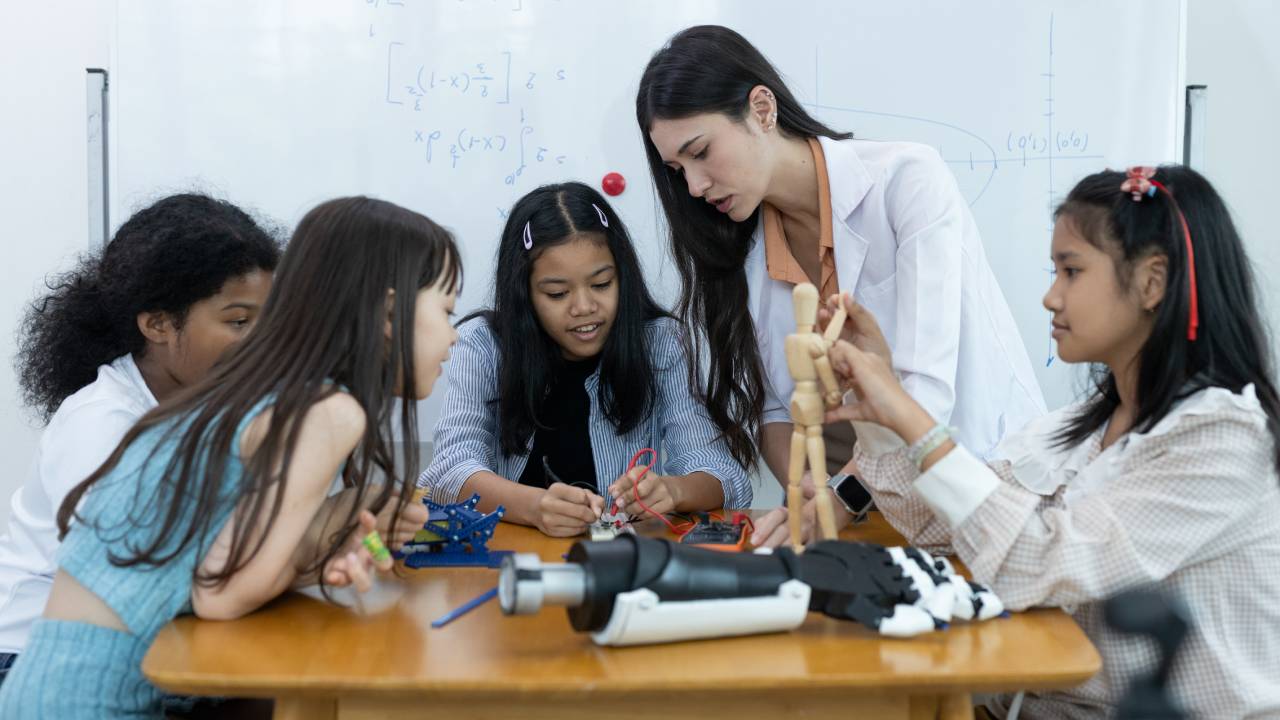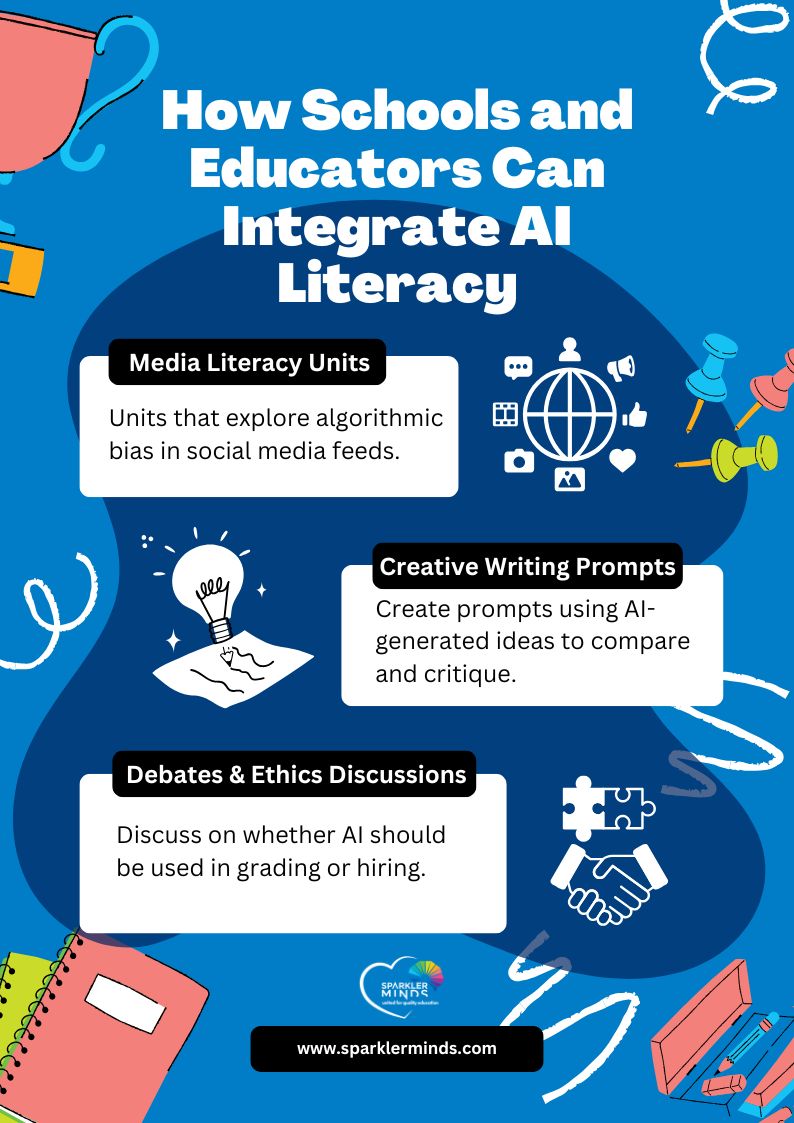What Every Parent And Educator Must Know About Ai Literacy In 2025

What Every Parent And Educator Must Know About Ai Literacy In 2025
In just the past year, artificial intelligence has gone from a futuristic buzzword to an almost irreplaceable daily companion. Whether it's ChatGPT helping students brainstorm essays, AI assistants organizing family schedules, or machine learning models powering personalized learning apps, AI is rapidly reshaping how we live, learn, and work. The pace is dizzying, and it's only accelerating!
Yet, while AI tools are becoming mainstream, our education systems are lagging far behind. A 2023 UNESCO report found that fewer than 10% of school curriculums globally included any structured content about artificial intelligence or digital ethics. This gap leaves students unprepared for a future where AI fluency will be as fundamental as reading and math. Imagine a student navigating a world filled with autonomous decision-making, data-driven platforms, and digital misinformation, without any understanding of how these systems work or how to interact with them responsibly.
That's why 2025 isn't just another year on the calendar, it's the tipping point. As AI becomes more embedded in our daily lives, AI literacy can no longer be optional. It is a necessity! Every student, regardless of their career path, needs to understand how AI impacts their world, shapes their choices, and influences their future. And it starts with us, parents, educators, and mentors, who have the power to bridge this critical knowledge gap.
What is AI Literacy?
AI literacy isn't about turning every student into a computer scientist or engineer. At its core, it's about equipping young people with the understanding, mindset, and skills they need to interact meaningfully with artificial intelligence in their everyday lives.
Think of it this way: just like digital literacy helped a generation navigate the internet, AI literacy is the toolkit for navigating a world powered by algorithms and machine learning. It's about knowing what AI is, how it works, where it shows up, and most importantly, how to use it wisely and critically.
Many students today are already using AI tools, whether they realize it or not. From autocorrect in their messages to AI-driven recommendations on YouTube or Spotify, AI is everywhere. But using AI is not the same as understanding AI. That's the crucial distinction. AI usage is passive; AI literacy is active. It empowers students to question how these tools work, what data they're trained on, what biases they may carry, and how to engage with them responsibly.

Core components of AI literacy include:
-
Critical Thinking: The ability to evaluate AI outputs, question their accuracy, and assess their relevance. Students should be able to ask,
Why did the AI suggest this?
orIs this result fair or biased?
-
Ethical Use: Understanding the impact of AI on privacy, fairness, misinformation, and decision-making. This means discussing not only what AI can do, but what it should do.
-
Prompt Engineering: Learning how to communicate effectively with AI systems, writing clear, purposeful prompts that produce useful, meaningful results. This is an emerging skill that parallels the way we once taught students how to search the web efficiently.
-
Understanding Models: A basic grasp of how AI models are trained, what data they rely on, and how they evolve. Students don't need to build models themselves, but they should understand the architecture behind them.
In short, AI literacy helps students go from passive consumers to empowered participants in an AI-driven world. And the earlier we start, the better prepared they'll be.
Why 2025 Is a Critical Year
The world has crossed a threshold. Artificial intelligence is no longer emerging, it has emerged! In 2025, AI is not a trend on the horizon; it's the infrastructure of the present.
We're already seeing an explosion of AI adoption across every major sector:
-
In education, AI is personalizing learning at scale, adapting lessons to individual student needs, indentifying learning gaps, and even automating administrative tasks for teachers.
-
In the workplace, tools like ChatGPT, Midjourney, and GitHub CoPilot are accelerating productivity, automating content generation, and reshaping how teams collaborate.
-
In media and content creation, AI is co-authoring books, composing music, designing graphics, and editing videos, all within seconds.
-
In decision-making, AI is helping businesses forecast demand, healthcare providers diagnose diseases, and governments plan cities.
For students, this means the careers they're preparing for will demand a whole new set of digital fluencies. According to the World Economic Forum's Future of Jobs Report 2025, employers expect that 39% of workers' core skills will change by 2030, and 59% of the global workforce will require reskilling or upskilling. This includes roles across industries, such as marketing, finance, law, medicine, education, logistics, and more, highlighting the growing importance of adaptibility and AI fluency in the years ahead.
Even today, students use AI-powered tools to:
-
Get tutoring help on platforms like Khanmigo (powered by GPT).
-
Write first drafts, brainstorm ideas, or create visuals for school projects.
-
Practice languages through AI-driven conversation bots.
-
Apply to universities using AI-enhanced application guidance.
But here's the catch: not all students are benefitting equally. The digital divide is widening, not just in terms of internet access, but in AI access and understanding. Students in schools or communities that aren't integrating AI literacy are at risk of failing behind, not just academically, but in long-term career readiness.
And that's where parents and educatores come in, as gatekeepers, guides, and advocates for preapring students to thrive, not just survive, in the AI era.
The Role of Parents and Educators
While AI may seem like a complex frontier reserved for tech giants and programmers, the truth is that the responsibility to guide children through the AI era lies closest to home and school. Parents and educators play a pivotal role, not just in introducing tools, but in shaping the attitudes, ethics, and understanding that students carry forward.

How Parents Can Nurture Curiosity and Digital Awareness
Parents don't need to be AI experts to raise AI-literate children. What matters more is creating a home environment that encourages questions, exploration, and critical thinking about the digital world.
-
Ask questions together: Instead of telling children what AI is, explore it with them. Ask,
How do you think Netflix recommends your shows?
orWhy did this chatbot give that answer?
-
Model responsible tech use: Demonstrate balanced screen time, fact-checking online information, and reading terms of service (at least the important parts).
-
Introduce accessible tools: There are child-friendly AI platforms like Google's Teachable Machine or MIT's Scratch with AI extensions that make learning interactive and fun.
Most importantly, treat AI as a conversation, not a lecture. Kids are naturally curious. When adults engage with that curiosity instead of shutting it down, learning follows.
How Schools and Educators Can Integrate AI Literacy

Many educators feel overwhelmed at the idea of teaching AI without advanced degrees or high-tech labs. The good news is, AI literacy doesn't have to mean coding neural networks. It can start with foundational conversations:
-
Media literacy units that explore algorithmic bias in social media feeds.
-
Creative writing prompts using AI-generated ideas to compare and critique.
-
Debates and ethics discussions on whether AI should be used in grading or hiring.
Simple classroom activities like analyzing how a chatbot answers questions, or how AI art tools interpret different prompts, can be powerful gateways into deeper thinking.
Additionally, organizations like AI4K12 offer free resources for educators to start integrating AI topics with age-appropriate lessons. Schools don't need cutting-edge infrastructure, they just need to commit to preparing students for a tech-rich world.
Addressing Common Fears and Misconceptions
Understandably, many parents and educators are wary of AI. They worry it will make students lazy, invade privacy, or replace human jobs. These fears are not unfounded, but they can be addressed with perspective:
-
AI is a tool, not a replacement. Like calculators or the internet, it enhances what students can do when used wisely.
-
Privacy matters and it can be taught. AI literacy includes understanding data rights and online safety.
-
It's not about memorizing facts anymore. The role of education is shifting toward critical thinking, creativity, and adaptability, skills that thrive in AI-augmented learning environments.
By stepping into the conversation, parents and educators don't just protect students from AI's risks, they empower them to shape its possibilities.
What AI-Literate Students Can Do
When students understand AI, they don't just use it, they shape it! AI Literacy empowers them to transition from passive consumers of technology to active creators and informed citizens in a digital society.
From Consumers to Creators
Most students today are adept at using AI-powered apps, whether it's generating art with a few taps or getting instant answers from chatbots. But AI-literate students go a step further: they ask how these tools work, why they give certain outputs, and what else they could be used for.
-
They learn to design better prompts, understanding how to guide AI toward useful, ethical, and creative results.
-
They experiment, using AI not just to consume content, but to create poems, code, business ideas, and solutions to real-world problems.
-
They understand the limitations of AI and know when human insight is irreplaceable.
With these skills, students become makers in an AI economy, not just users.
Navigating Misinformation and Bias
One of the most critical aspects of AI literacy is developing a strong compass for truth and fairness. AI systems are trained on vast amounts of human-generated data, which means they can inherit our biases, blind spots, and flaws.
AI-literate students:
-
Question the source: They ask where AI-generated information comes from, and whether it might be incomplete or slanted.
-
Spot patterns of bias: They recognize when algorithms reinforce stereotypes or filter content unfairly.
-
Think ethically: They consider the consequences of using AI in different settings, from social media to job applications.
In a time when misinformation spreads faster than ever, AI literacy is a crucial defence against digital manipulation and misinformation.
Preparing for Jobs that Don't Exist Yet
According to Dell Technologies and the Institute for the Future, 85% of the jobs that will exist in 2030 haven't even been invented yet. These roles will emerge at the intersection of human creativity and machine intelligence, and today's students will be the first to fill them!
AI-literate students will be prepared to:
-
Collaborate with AI tools across industries: from law and healthcare to agriculture and design.
-
Adapt to rapidly changing job markets with confidence and curiosity.
-
Think entrepreneurially, solving problems and launching ideas in AI-enhanced environments.
They won't just follow technology, they'll lead with it!
How to Start Today
You don't need a computer science degree or a classroom full of gadgets to begin your child or student's AI literacy journey. What you do need is a willingness to explore, ask questions, and guide them in becoming thoughtful, empowered digital citizens.
Tips and Resources to Begin With

Start small, start curious. Here are some accessible and engaging tools to help:
-
Books:
-
Hello Ruby: Journey Inside the Computer by Linda Liukas - ideal for young learners.
-
Machine Learning For Kids: A Playful Introduction to Artificial Intelligence by Dale Lane - a visual, beginner-friendly guide.
-
You Look Like a Thing and I Love You by Janelle Shane - for older students or adults to understand AI humor and bias.
-
-
Web Tools and Platforms:
-
Teachable Machine (Google) - lets kids train simple AI models using images, sound, or poses.
-
Scratch + AI Extension - ideal for introducing coding with a creative twist.
-
Khan Academy (Khanmigo) - offers AI-powered tutoring and exploration tools.
-
MIT Media Lab's AI + Ethics Curriculum - free, classroom-ready materials.
-
-
Videos & Podcasts:
-
CrashCourse AI Series on YouTube - great for middle and high schoolers.
-
The key isn't to master AI overnight, it's to create ongoing engagement, led by curiosity and critical thinking.
Encourage Guided Exploration and Ethical Conversations
AI isn't just technical, it's social. So as students explore tools, encourage them to ask:
-
Who made this AI?
-
What data is it using?
-
What could go wrong if someone misused it?
Make ethics a regular part of tech conversations. When students see an AI-generated ad, a filtered video, or an AI-written article, help them unpack its source and intent. These aren't just tech skills, they're life skills for the digital age.
Where Sparkler Minds Comes In
At Sparkler Minds, we believe every child deserves to understand the tools shaping their future. That's why we offer beginner-friendly AI programs designed for young learners, blending creativity, critical thinking, and ethics in a hands-on, age-appropriate way.
Whether you're a parent eager to guide your child, or an educator ready to bring AI literacy into the classroom, our programs are here to support your journey, because the future doesn't wait!
Conclusion
We're living through a defining moment in history, where the tools we once imagined are now shaping our daily reality. AI isn't just changing how we search, learn, and work; it's transforming what it means to be prepared for the future.
But this transformation doesn't diminish the role of learning, it elevates it! AI doesn't replace education; it reframes it. It invites us to teach not just facts, but frameworks. Not just answers, but questions. Not just content, but curiosity, ethics, and adaptability.
The urgency is real, but so is the opportunity. We have the chance to raise a generation that isn't afraid of technology, but empowered by it. A generation that doesn't just adapt to AI, but leads with humanity in an AI-shaped world.
So, the question we must ask ourselves is this:
Are we preparing our students for the world they'll grow into, or the world we grew up in?
